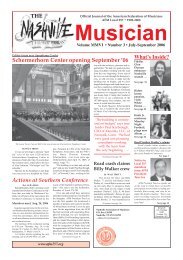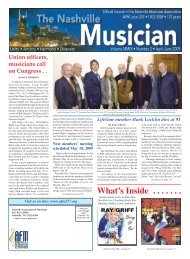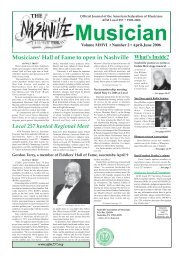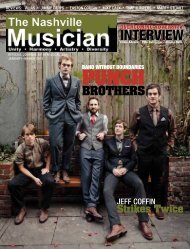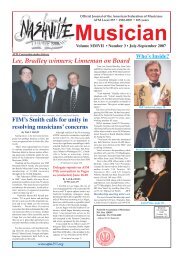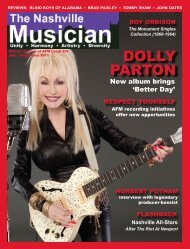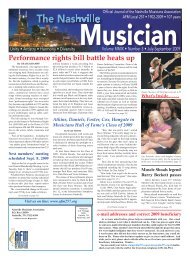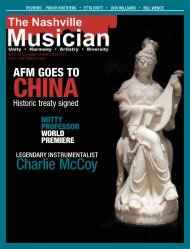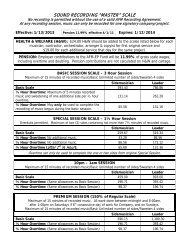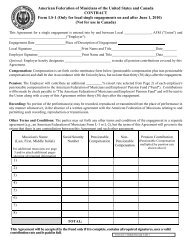Musicians Web pages - Nashville Musicians Association
Musicians Web pages - Nashville Musicians Association
Musicians Web pages - Nashville Musicians Association
You also want an ePaper? Increase the reach of your titles
YUMPU automatically turns print PDFs into web optimized ePapers that Google loves.
34 The <strong>Nashville</strong> Musician April-June 2007<br />
George Chestnut at his desk.<br />
By WALT TROTT<br />
The George Henry Chestnut we interviewed<br />
15 months ago was far from the chipper<br />
instrument repairman, who welcomed us<br />
on the day after his 75th birthday.<br />
Chestnut was quick to point out how<br />
thankful he was for the treatment rendered by<br />
a new physician: “I didn’t think there were any<br />
more like him out there. He’s a fellow in his<br />
mid-50s, a really good doctor, who’s very thorough<br />
and he cares.”<br />
After suffering an aneurysm, the ongoing<br />
pain of an inoperable hernia, and problems encountered<br />
with a new pace-maker, Chestnut’s<br />
made significant gains under this physician.<br />
At one point, he grew so exasperated at<br />
the care or lack of it he was receiving that he<br />
removed the tubes from his arms, got dressed,<br />
and walked out of the hospital.<br />
“Some people told me they thought I was<br />
dead, I guess after reading stories in The Tennessean<br />
and in your newspaper,” mused Chestnut,<br />
“Now we’ll let ’em know I’m back on the<br />
job.”<br />
Chestnut’s specialty is restoration and repairing<br />
of violins, fiddles, violas, cellos, basses<br />
and restoration, repairing and rehairing of<br />
bows, as well.<br />
“I also work on fretted instruments, fret<br />
work, repair bridges, setting intonation and<br />
work on dobros . . .”<br />
George even hopes to recruit his wife, fellow<br />
Local 257 guitarist Jennie Jo Chestnut, to<br />
work with him in his Donelson instrument repair<br />
shop.<br />
“I want to get her back in the business. If<br />
she don’t learn this, when I die, it will all go<br />
to the grave with me. I’ve tried five or six apprentices<br />
before, but Lord, they’d lie to you,<br />
steal from you and everything else. I can’t<br />
stand that, so no more.”<br />
George’s grown children are musically<br />
talented, but not here to carry on their dad’s<br />
business: “My daughter plays piano, and my<br />
son plays guitar and dobro. He’s a preacher.”<br />
As a youngster himself, recalls George,<br />
“my granddaddy raised me. I asked him once<br />
about playing (an instrument), but he knocked<br />
that in the head . . . Come to find out, however,<br />
in his younger days he played fiddle, fivestring<br />
banjo and called for square dances. So<br />
he was very much involved in music, but he<br />
didn’t want me to be no musician.”<br />
While living in Lakeland, Fla., George<br />
was intent on playing music. How did he decide<br />
on playing bass guitar?<br />
“Well, it’s a long story, but we got together<br />
- and that’s when they had them ol’ electric<br />
guitars and the amplifier was built into the<br />
case. You’d prop ’em at a 90 degrees (angle)<br />
Here’s his wife’s shot of a young George Chestnut.<br />
George Chestnut takes a bow<br />
and plug ’em in - and had a bunch over to the<br />
house, about 10 of us, and there were 10 electric<br />
guitars! None of them was in tune, and loud! I<br />
said, ‘Lord o’ mercy! It looks to me like somebody<br />
would bring in something else to play besides<br />
guitar. They’re about to drive me nuts.’<br />
“Well, I was on the job and this ol’ boy says<br />
to me, ‘I got something at the house I think you<br />
would like.’ What’s that?, I asked. ‘I got an upright<br />
bass. It’s in the wife’s laundry room and<br />
she says if I don’t get it out of there this evening,<br />
she’s gonna take it out in the yard and burn it.’<br />
So I went by, looked at that thing and it was<br />
painted black enamel . . . So I asked, ‘How much<br />
you want for it?’ He said $10, and I told him, ‘I<br />
ain’t got $10 on me, but I’ll have it payday.’ He<br />
told me, ‘Don’t worry about it, just take it on<br />
home and if you can’t use it, throw it away.’<br />
“So I took it home, stripped it down and it<br />
had some of the prettiest maple on it you ever<br />
seen. It took wood bleach to get all that black out<br />
of the wood. I hung it up in a tree and took the<br />
spray gun to it and colored it.<br />
“I took that bass over to a buddy of mine and<br />
said, ‘Show me where the G chord, C chord and<br />
E chord are and don’t show me no more.’ Well, I<br />
practiced and played with the radio. Then we<br />
started up a band - a six-piece band - with a female<br />
singer who sounded just like Loretta Lynn.”<br />
Chestnut had linked up with his elder brother,<br />
and were known as Dallas Chestnut & The Country<br />
Ramblers: “We fronted for <strong>Nashville</strong> musicians<br />
like Pete Drake, his brother Jack Drake,<br />
Dale Sellers and a whole lot of those guys. We<br />
played regularly at a big dude ranch. My brother<br />
played guitar and sang. He was amazing. I sang<br />
some and played electric bass and guitar. We did<br />
that about 12 years.<br />
“One night, Jack Drake came down and he<br />
played like 24 or 25 years with Ernest Tubb(’s<br />
Texas Troubadours). So I pulled up a chair there<br />
and stole every lick he had on the bass. Jack was<br />
my hero.”<br />
So does he still have that vintage bass?<br />
“I brought that bass to <strong>Nashville</strong> and I sold it<br />
to Lightning Chance, when he was playing at<br />
WLAC with Stan Hitchcock. Lightning played<br />
on it for years. Finally, Johnny Cash bought it<br />
off Lightning, but somebody had painted it again.<br />
I told someone that bass used to be beautiful, and<br />
they told Cash. So he said, ‘Tell George to scrape<br />
that thing down and fix it like it used to be when<br />
he had it.’ So I put that bass back in order, and it<br />
was hanging in Johnny’s museum last I knew.<br />
Don’t know what’s happened to it now”<br />
While still in Florida, George got into instrument<br />
repair, putting his carpenter skills to profitable<br />
use. He also made good contacts with national<br />
musicians, especially bluegrassers.<br />
“We were all over the state. Jim & Jesse, The<br />
Osbornes, Bill Monroe, all those <strong>Nashville</strong> acts<br />
used to come down for the bluegrass festivals.<br />
We’d go there, carry a barbecue grill, go to the<br />
store, buy some T-bone steaks, find us a little<br />
hideout and we’d have a big dinner for them with<br />
plenty of cold beer, until Bill showed up, then<br />
the beer disappeared,” he laughs.<br />
About this time, George got burned-out playing<br />
gigs: “For four or five years, I wouldn’t touch<br />
a bass to play. I’d work on ’em though. I thought,<br />
you make more money working on instruments<br />
than playing on them.”<br />
Word-of-mouth regarding his repair expertise<br />
reached the ears of notables like Monroe, Roy<br />
Acuff, Tommy Jackson, Jerry Rivers and Skeeter<br />
Willis (of the Willis Brothers).<br />
“When I first started coming up to <strong>Nashville</strong>,<br />
there were shops doing guitar repair, so I thought<br />
I would cater to the fiddle players.”<br />
Indeed, Chestnut made regular visits to Music<br />
City, where he would pick up fiddles in need<br />
of repair or restoration, take them home to work<br />
on and then return to make the deliveries.<br />
“I’d leave on Friday afternoon and be back<br />
Sunday night because then I worked in<br />
constuction. Had 35 or 40 men there, and so I<br />
had to be back on the job Monday morning.”<br />
- ‘For four or five years, I wouldn’t<br />
touch a bass to play. I’d work on ’em<br />
though . . . You make more money working<br />
on instruments than playing on them.’ -<br />
Kathy Shepard took this random shot of Chestnut’s workplace in Donelson.<br />
How did George meet wife Jennie?<br />
“I was doing some fiddle work for her<br />
brother (Loie Fraine) for about three years.<br />
I had lived with the devil’s sister 25 years,<br />
and it was three or four years before I finally<br />
got out of Dodge. But he kept telling<br />
me he had a sister . . . When I got to know<br />
her, I knew she was my true soul mate.”<br />
According to Jennie: “On May 6, we’ve<br />
been married 28 years . . . I’m also from a<br />
music family, but we just played around at<br />
square dances and such. My mom’s selftaught,<br />
my father and my oldest brother<br />
played guitar, then he wanted to play fiddle.<br />
So, I was elected to play guitar.”<br />
“Don’t be so modest,” interrupts<br />
George. “She went over to Raymond<br />
Fairchild’s (Florida) theater and played with<br />
Roni Stoneman. I been knowin’ Raymond<br />
since I was 16 or 17 years old, and played<br />
at dances with him. He praised her high,<br />
saying she played the greatest (rhythm)<br />
guitar, and when she sang a Ray Price song<br />
there, she got three standing ovations!”<br />
(Fairchild himself was a superb banjo<br />
player, a five times national champion.)<br />
Chestnut added to his instumental<br />
knowledge, working briefly with the<br />
Dopyera brothers (John and Rudy) in California,<br />
“as the only factory rep they ever<br />
had.”<br />
(Of course, the siblings had perfected<br />
the resophonic guitar, dubbed “Dobro,” a<br />
combination of the Slavik word good and<br />
their surname.)<br />
After relocating to <strong>Nashville</strong>, George’s<br />
client list grew, including such luminaries<br />
as Vassar Clements, Merle Haggard, Henry<br />
Strzelecki, Johnny Gimble, Tom Rutledge,<br />
Randy Howard, Bob Babbitt, Stella Parton,<br />
Dave Pomeroy, Glen Duncan, Rufus<br />
Thibodeaux, Louise Mandrell, Roland<br />
White, Marty Raybon, James Monroe,<br />
Mike Bub, Billy Grammer, Rick Morton,<br />
Roy Huskey, Jr. and Kenny Baker.<br />
Regarding Baker, Chestnut remembers<br />
them making extended stays at Bill<br />
Monroe’s Beanblossom festivals: “Used to<br />
go to Beanblossom all the time, me and<br />
Kenny Baker. I had him selling fiddles and<br />
I’d take all my work tools up and work off<br />
the tailgate of my truck . . . I’d give Kenny<br />
his sales commission and he said he was<br />
making more selling fiddles than he was<br />
performing.”<br />
George also has fond memories of the<br />
late Junior Huskey: “I never met big Junior<br />
(his dad), but young Junior used to come<br />
out to the house and jam. He was a good<br />
picker. Actually, me and him played just<br />
alike. I mean if you were in another room<br />
and we were in here pickin’ the bass, you’d<br />
have to come in to see which of us were<br />
playin’ because I picked just like he did.”<br />
Huskey wasn’t the only one to visit<br />
Chestnut’s basement workshop on occasion<br />
to jam with the Florida native, among others<br />
were Monroe, Acuff, Earl Scruggs, Mac<br />
Wiseman and Bashful Brother Oswald.<br />
Perhaps the maddest gathering occurred<br />
one year from Christmas eve until New Year’s<br />
eve, notes Chestnut: “We held it out in the<br />
garage. There were like 270 people there.”<br />
Jennie Jo remembers the time they had a<br />
Cajun feast: “Jimmy C. Newman said, ‘Jennie,<br />
this is the best rice I’ve ever eaten. How do<br />
you do it?’ I told him, ‘boil the hell out of it!’”<br />
At one time, Chestnut also repaired instruments<br />
for the <strong>Nashville</strong> Metro School System.<br />
“But they always seemed to run out of money<br />
for stringed instruments.”<br />
Does Chestnut build instruments?<br />
“I never built instruments. But I have converted<br />
them for years and years. For Larry<br />
Franklin (top session player), I converted a<br />
four-string into a five-string . . .”<br />
In fact, Chestnut created something special<br />
for Franklin, which was trademarked as a<br />
Chin-Cello.<br />
“I own the first five-string Chin-Cello<br />
made by George Chestnut,” recommended<br />
Franklin. “And I used the Chestnut Strings, as<br />
well. I am very happy with this set-up and I<br />
highly recommend the Chestnut Strings for<br />
your baritone violin.”<br />
George adds, “Here’s a history of the baritone<br />
violin. John Berry was a violinist. You<br />
know (Itzhak) Perelman and all those highfalutin’<br />
classical players, they learned from<br />
him. Well, he didn’t like the tone of the high<br />
tinny strings on a violin, so he came out in<br />
1960, with the baritone violin and then he<br />
dropped it in the 1970s. I came out with it from<br />
there (using Super Sensitive Strings) - and<br />
Rick Campbell, a good friend of mine who<br />
lives over in Knoxville, is the one who named<br />
it the Chin-Cello. (Incidentally, Berry and partner<br />
Les Barcus introduced the first electric violin.)<br />
“I was the one built the first five-string<br />
baritone Larry’s still playing. He was the first<br />
(Continued on page 35)<br />
Jennie and George Chestnut.<br />
- Photos (4) by Kathy Shepard<br />
UN



